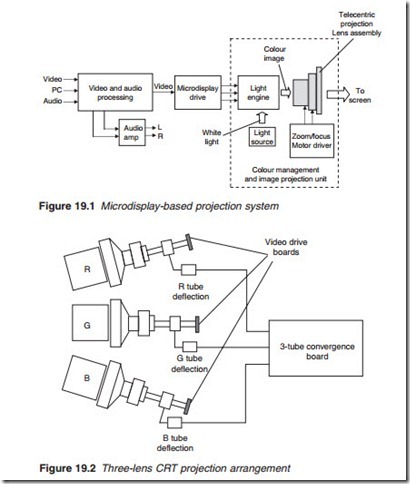Projection systems
Projection displays utilise an optical system to magnify a small picture created either by a conventional direct-view technology, such as a CRT, or by the use of light modulating system (LMS). An LMS employs a 3–5 cm microdisplay panel as a light valve (LV) to modulate the light. A projection display can be operated either in front-projection (FP) mode, where the viewer and projector are on the same side of the screen, or in rear-projection (RP) mode, where the viewer and projector are on the opposite side of the screen.
There are three major LV technologies, namely the digital micromirror device (DMD), the high-temperature polycrystalline silicon (HTPS) and the liquid crystal on silicon (LCoS). Each technology has unique properties that determine the image quality.
A microdisplay-based projection system (Figure 19.1) consists of the following major parts:
● Video and audio processing
● Microdisplay drive
● Colour management and image projection
The colour management and image projection system contains the microdisplay, the light source assembly, the light engine and the telecen- tric optical lens. The input which could be in the form of composite, com- ponent or digital video is processed and the image resolution scaled to the native resolution of the microdisplay. RGB signals are then fed to the microdisplay drive on its way to the light engine. Stereophonic audio input is also processed and amplified as shown. Light from a light source assembly is directed to the microdisplay to be projected onto a screen via a telecentric projection lens. User adjustments are provided by position- controlled motors for focus and zoom.
First, we will consider the CRT-based projector.
CRT-based projection systems
The CRT-based projector was the first commonly used system and came to dominate the middle- and low-end RP system market for a number of years. Three single-colour (R, G or B) tubes, each optimised for luminance and beam spectrum of the appropriate primary colour, are used to project three converging images onto the screen. Since the path of the electron beam in the small size CRT is relatively short, the beam spot size can be better controlled, minimising any smearing effects. These features are
required to produce high resolution and good colour reproduction with high brightness. There are two configurations for CRT projectors, using either three lenses or a single lens.
In the three-lens configuration, each tube is dedicated to a primary colour projecting its own individual image on the screen. The three images are con- verged by deflection of the off-axis R and B tubes as shown in Figure 19.2 to produce a colour image. Convergence is the most challenging problem in this type of CRT-based projector. For good quality image, it is desirable to
converge the images from the three tubes to within one-half pixel. The three- lens arrangement suffers from two main drawbacks: keystone distortion caused by the trapezoidal images produced by the off-axis R and B tubes and colour non-uniformity due to the angular dependence of the reflection coefficient of the optical system. They are obviated by suitable convergence circuitry and by tilting the blue and red lenses, respectively.
In the single-lens CRT configuration, a dichroic mirror is used to merge and converge the three images as shown in Figure 19.3. Even though single- lens CRT projectors are free from convergence errors, there arise other con- vergence problems caused by optical, electrical and magnetic issues such as the long back focal length.
High performance CRT projection systems have a long and proven track record for professional high-resolution graphics and premium qual- ity video presentations. Their wide range of signal input compatibility, edge and colour matching, excellent black level and geometry correction are key reasons for the continuing success of this technology. In addition, the mature CRT technology provides highly reliable and maintainable projectors at affordable pricing.
However, these projectors are not as bright on images with mostly white content. Furthermore, the Gaussian beam-shape of the scanning electron beam reduces image sharpness when compared with a fixed pixel display operating at its native resolution. Convergence drift and CRT phosphor burn require regular servicing of the projector.
Another disadvantage of CRT projectors is its large size. There is a trade-off between the cabinet size and image quality. A shorter focal length lens decreases the optical throw distance and allows a thin cabinet. However, it increases offset angles between tubes, which results in poor image quality due to increased electron beam deflection.

